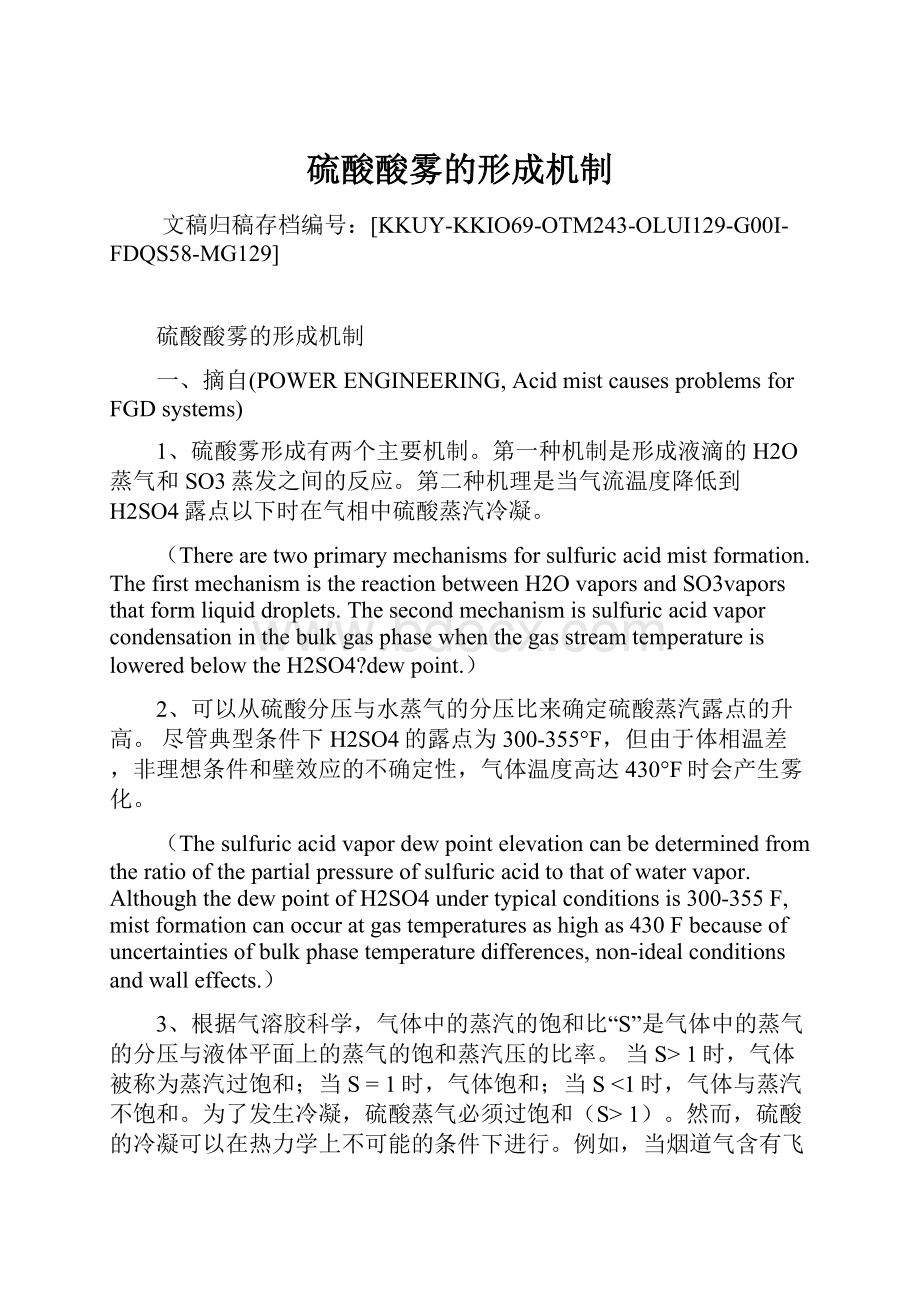硫酸酸雾的形成机制.docx
《硫酸酸雾的形成机制.docx》由会员分享,可在线阅读,更多相关《硫酸酸雾的形成机制.docx(5页珍藏版)》请在冰豆网上搜索。

硫酸酸雾的形成机制
文稿归稿存档编号:
[KKUY-KKIO69-OTM243-OLUI129-G00I-FDQS58-MG129]
硫酸酸雾的形成机制
一、摘自(POWERENGINEERING,AcidmistcausesproblemsforFGDsystems)
1、硫酸雾形成有两个主要机制。
第一种机制是形成液滴的H2O蒸气和SO3蒸发之间的反应。
第二种机理是当气流温度降低到H2SO4露点以下时在气相中硫酸蒸汽冷凝。
(Therearetwoprimarymechanismsforsulfuricacidmistformation.ThefirstmechanismisthereactionbetweenH2OvaporsandSO3vaporsthatformliquiddroplets.ThesecondmechanismissulfuricacidvaporcondensationinthebulkgasphasewhenthegasstreamtemperatureisloweredbelowtheH2SO4?
dewpoint.)
2、可以从硫酸分压与水蒸气的分压比来确定硫酸蒸汽露点的升高。
尽管典型条件下H2SO4的露点为300-355°F,但由于体相温差,非理想条件和壁效应的不确定性,气体温度高达430°F时会产生雾化。
(Thesulfuricacidvapordewpointelevationcanbedeterminedfromtheratioofthepartialpressureofsulfuricacidtothatofwatervapor.AlthoughthedewpointofH2SO4undertypicalconditionsis300-355F,mistformationcanoccuratgastemperaturesashighas430Fbecauseofuncertaintiesofbulkphasetemperaturedifferences,non-idealconditionsandwalleffects.)
3、根据气溶胶科学,气体中的蒸汽的饱和比“S”是气体中的蒸气的分压与液体平面上的蒸气的饱和蒸汽压的比率。
当S>1时,气体被称为蒸汽过饱和;当S=1时,气体饱和;当S<1时,气体与蒸汽不饱和。
为了发生冷凝,硫酸蒸气必须过饱和(S>1)。
然而,硫酸的冷凝可以在热力学上不可能的条件下进行。
例如,当烟道气含有飞灰时,飞灰可以作为蒸汽的冷凝核。
当烟气流过排放控制系统的冷却器阶段时,硫酸蒸气在飞灰上冷凝。
(Accordingtoaerosolscience,thesaturationratio"S"ofavaporinagas,istheratioofthepartialpressureofthevaporinthegastothesaturationvaporpressureofthevaporoveraplaneoftheliquid.WhenS>1,thegasissaidtobesupersaturatedwithvapor;whenS=1,thegasissaturated;andwhenS<1,thegasisunsaturatedwithvapor.
Forcondensationtotakeplace,sulfuricacidvapormustbesupersaturated(S>1).However,thecondensationofsulfuricacidcantakeplaceunderconditionswhereitisthermodynamicallyimpossible.Forexample,whenthefluegascontainsflyash,theflyashmayactasanucleusofcondensationforthevapor.Thesulfuricacidvaporscondenseontheflyashasthefluegasflowsthroughthecoolerstagesoftheemissionscontrolsystem.)
4、硫酸冷凝的另一机制(当S<1)在较冷的表面上冷凝时,如果设备壁的温度明显低于气流的温度,则会发生。
这发生在靠近壁表面的非常薄的层状边界层中。
由于层状层的厚度是总气体体积的一小部分,所以即使对于热交换器表面,这种冷凝机理通常也不会产生大量的硫酸雾。
Anothermechanismforsulfuricacidcondensation(whenS<1)iscondensationoncoldersurfaceswhichtakesplaceifthetemperatureoftheequipmentwallsissignificantlylowerthanthetemperatureofthegasstream.Thisoccursintheverythinlaminarboundarylayerclosetothewallsurface.Becausethethicknessofthelaminarlayerisasmallpercentageofthetotalgasvolume,evenforheatexchangersurfaces,thiscondensationmechanismwillnotgenerallyprovideaconsiderablequantityofsulfuricacidmist.
5、然而,高饱和度的层流层可能是产生最大的部分硫酸液滴的最好机制。
例如,在SCR系统的下游,其中烟道气体温度为约480°F,硫酸蒸气浓度为50ppm,硫酸雾形成比小于1.0。
在这些条件下,已经在层状层中开始了硫酸的气相冷凝。
However,thehighsaturationratiointhislaminarlayermaybethemechanismthatproducesthelargestportionofthefinestsulfuricaciddroplets.Forexample,downstreamofanSCRsystem,wherethefluegastemperatureisabout480Fandtheconcentrationofsulfuricacidvaporis50ppm,thesulfuricacidmistformationratioislessthan1.0.Attheseconditionsthegasphasecondensationofsulfuricacidhasalreadybeguninthelaminarlayer.
6、当发生慢气体骤冷时,例如通过使用间接接触冷凝器,也可能发生层状层中形成雾的过程。
通过缓慢的冷却过程,飞灰的存在是一个重要因素,因为它提供了一个较大的表面积,蒸气可以冷凝。
这种冷却的优点是,大多数酸会在现有的飞灰颗粒和冷凝器壁。
另一方面,大多数FGD系统使用快速淬火技术,其中热烟气与水的直接接触冷却。
该过程通过均匀成核固有地产生大量的硫酸液滴。
Theprocessofmistformationinthelaminarlayermayalsooccurwhenslowgasquenchingtakesplace,suchasthroughtheuseofanindirectcontactcondenser.Withaslowcoolingprocessthepresenceofflyashisanimportantfactorbecauseitprovidesalargesurfaceareaonwhichthevaporscancondense.4?
Theadvantageofthistypeofcoolingisthatmostoftheacidwillbecondensedontheexistingflyashparticlesandthecondenserwalls.Ontheotherhand,mostFGDsystemsuserapidquenchingtechnologieswithdirectcontactcoolingofthehotfluegaswithwater.Thisprocessinherentlygeneratesalargenumberofsulfuricaciddropletsbyhomogeneousnucleation.
二、摘自(SulfuricAcidMistGenerationinUtilityBoilerFlueGas)
1、Sulfuricacidformationtakesplacethroughthereactionstepsof:
OxidationofSO2toproduceSO3
(1)followedbyreactionwithH2OtoformH2SO4
(2):
SO2+?
O2→SO3
(1)
SO3+H2O→H2SO4
(2)
由于SO2和O2反应形成SO3(反应1)是放热的,所以在高温(1400℃以上)下形成很少的SO3。
在600℃时,约70%的SO2可以转化为SO3,但反应速度慢得多。
SincethereactionofSO2andO2toformSO3(Reaction1)isexothermic,littleSO3formsathightemperatures(above1400?
C).At600?
C,about70%oftheSO2canbeconvertedtoSO3,butthereactionrateismuchslower.)
2、在典型的400℃(750F)条件下,SO2氧化为SO3不超过2%。
当燃烧气体从1600-1700℃冷却至约1000℃时,锅炉烟道气中的大部分SO3可能在数秒钟内形成。
SO3的产生也随着烟道气中氧浓度的增加而增加(反应1),然而,如图1所示,最小化燃烧气体中的氧会增加颗粒。
Undertypicalconditionsof400?
C(750?
F),theoxidationofSO2toSO3isnomorethan2%[5].MostoftheSO3inboilerfluegaslikelyformsduringtheseveralsecondswhenthecombustiongascoolsfrom1600-1700?
Ctoabout1000?
C.SO3generationalsoincreaseswithrisingoxygenconcentrationinthefluegas(Reaction1),however,minimizingoxygeninthecombustiongaswouldincreaseparticulateasshowninFig.3、第一种机理是形成液滴的两种蒸气H2O和SO3(反应2)之间的反应。
气雾形成的第二种机理是通过降低气流温度超过H2SO4露点而在大气相中硫酸蒸汽冷凝。
ThefirstmechanismisthereactionbetweentwovaporsH2OandSO3(Reaction2)formingliquiddroplets.ThesecondmechanismofmistformationissulfuricacidvaporcondensationinthebulkgasphasebyloweringthegasstreamtemperaturebeyondtheH2SO4dewpoint.
4、雾化的第二种机理是通过本体中的蒸气冷凝通过将气流温度降低到低于硫酸露点的气相。
必须指出的是,尽管典型条件下H2SO4的露点为150-180℃,但由于体相温度差异不确定,非理想条件和壁效应,气体温度可高达220℃。
当包含SO3,H2SO4和H2O蒸汽的气流被冷却时,H2SO4蒸气冷凝,并且SO3蒸气和H2O蒸气反应以形成另外的H2SO4。
当气体被更快地冷却时,形成非常细的亚微米雾颗粒,可冷凝的蒸汽可以通过传质,即“冲击冷却”去除。
当含有SO3的干燥气流与湿气流混合时,可以发生相同的效果。
对于这种情况,两种气流的快速混合显着地使H2SO4液滴尺寸最小化。
Thesecondmechanismofmistformationoccursbyvaporcondensationinthebulkgasphasebyreducingthegasstreamemperaturebelowthesulfuricaciddewpoint.Itmustbenotedthat,althoughthedewpointofH2SO4undertypicalconditionsis150-180?
C,becauseofuncertaintiesofbulkphasetemperaturedifferences,non-idealconditionsandwalleffects,mistformationcouldoccuratgastemperaturesashighas220?
C[8].WhenagasstreamcontainingSO3,H2SO4andH2Ovaporiscooled,H2SO4vaporcondensesandSO3vaporandH2OvaporreacttoformadditionalH2SO4.Veryfinesubmicronmistparticlesareformedwhenthegasiscooledfasterthanthecondensablevaporcanberemovedbymasstransfer,i.e.“shockcooling”.ThesameeffectcantakeplacewhenadrygasstreamcontainingSO3ismixedwithawetgasstream.Forthiscase,rapidmixingofthetwogasstreamsdramaticallyminimizestheH2SO4dropletsize.
5、当混合后的H2SO4浓度范围为50-200ppm时,平均测量的液滴直径小于0.05mk。
但是,在高浓度硫酸的情况下,由于发生了粒子的规则缩合和生长,所以雾滴的大小实际上更大。
WhentheH2SO4concentrationaftermixingrangesfrom50–200ppm,theaveragemeasureddropletdiameterislessthan0.05mk.Butunderhighconcentrationofsulfuricacid,whereregularcondensationandgrowthofparticlestakeplace,themistdropletsizeisactuallylarger.
6、例如,气相中硫酸浓度为3.6%时,雾的平均直径为0.5mk。
在高浓度硫酸的表面上发生类似的雾形成过程。
在酸强度低于98.5%时,酸开始产生可测量的水蒸汽压力,这导致亚微米雾形成。
形成的液滴的直径取决于水的平衡分压。
当用硫酸表面蒸发的水分子足以与所有SO3反应时,液滴的直径是恒定的(水蒸气压0.06mmHg)。
如果酸雾与水饱和的气流接触,酸滴通过吸收水而生长。
如图所示。
最大的液滴含有最低浓度的硫酸。
然而,初始液滴尺寸取决于气相中水蒸气和三氧化硫的相对浓度。
Forexampleat3.6%concentrationofsulfuricacidinthegasphase,theaveragediameterofmistis0.5mk(Table1).Asimilarprocessofmistformationtakesplaceoverasurfaceofhighconcentrationsulfuricacid.Atacidstrengthsbelow98.5%,theacidbeginstoexertameasurablewatervaporpressure,whichcausessubmicronmistformation(Fig4)[8].Thediameteroftheformeddropletsdependsontheequilibriumpartialpressureofwater.Thediameterofthedropletisconstant(watervaporpressure0.06mmHg)whenthewatermoleculeswhichvaporizewiththesulfuricacidsurfacearesufficienttoreactwithalloftheSO3[9].Iftheacidmistcontactsthewatersaturatedgasstream,theaciddropletsgrowbyabsorptionofwater.AsshowninFig.5,thelargestdropletscontainthelowestconcentrationofsulfuricacid.However,theinitialdropletsizedependsontherelativeconcentrationofwatervaporsandsulfurtrioxideinthegasphase.